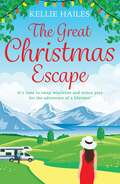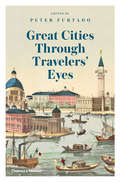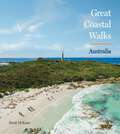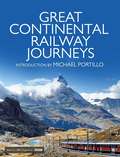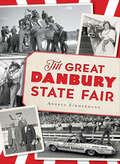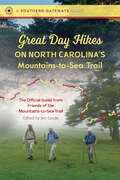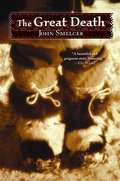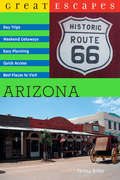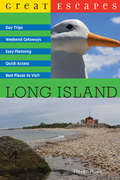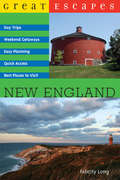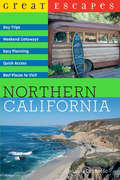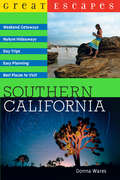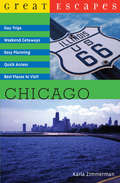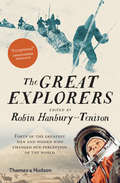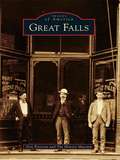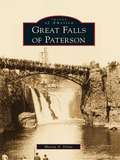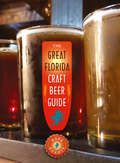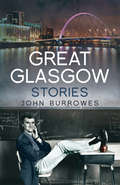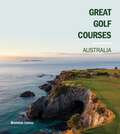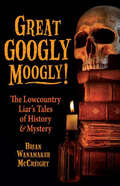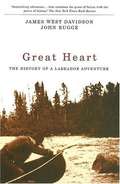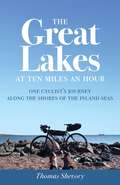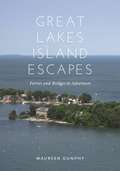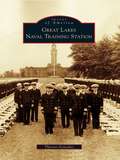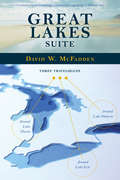- Table View
- List View
The Great Christmas Escape
by Kellie HailesIt's time to swap mistletoe and mince pies for the adventure of a lifetime! Sara's life has been in a bit of a rut. Lately, her job as a photographer has just meant taking photos of happy couples and families all day before returning to her empty flat. And while she normally loves Christmas with her family, this year a part of her just wants to run away. So when her ex-husband Fin gets in touch with a wild idea - a joint work trip to New Zealand - she knows it's crazy... but she says yes!A celebrated travel blogger, Fin has made a career out of following his bliss. As much as he loves Sara, the steady family life she's always wanted is not one he can give her. This trip together is his one chance to win her back. But can he convert her to his impulsive lifestyle? There's only one way to find out. As the two explore the stunning sights and thrills of New Zealand, they're about to discover there's so much more to each other than they ever realised...A Christmas romcom like no other, The Great Christmas Escape by Kellie Hailes is the perfect getaway read this year...
Great Cities Through Travelers' Eyes
by Peter FurtadoA wide-ranging anthology of travelers’ accounts in thirty-eight of the world’s most fascinating cities, from ancient times through the twentieth century. This entertaining new anthology includes travelers’ tales from thirty-eight cities spread over six continents, ranging from Beijing to Berlin, Cairo to Chicago, and Rio to Rome. The volume features commentators across the millennia, including the great travelers of ancient times, such as Greek geographer Strabo; those who undertook extensive journeys in the medieval world, not least Marco Polo; courageous women such as Isabella Bird and Freya Stark; and enterprising writers and journalists, including Mark Twain. We see the work of famous travelers, but also stories by ordinary people who found themselves involved in remarkable situations, like the medieval Chinese abbot who was shown around the Sainte-Chapelle in Paris by the king of France. Some of the writers seek to provide a straightforward, accurate description of all they have seen, while others concentrate on their subjective experiences of the city and encounters with the inhabitants. Introduced and contextualized by bestselling historian Peter Furtado, each account provides both a vivid portrait of a distant place and time and an insight into those who journeyed there. The result is a book that delves into the splendors and stories that exist beyond conventional guidebooks and websites.
Great Coastal Walks Australia
by Brent McKeanDiscover 40 of Australia's most spectacular coastal walking tracks.Great Coastal Walks Australia showcases each state's best coastal tracks to explore on foot. It features a range of unique locations that reveal Australia's most spectacular coastal scenery, from Sydney's iconic beaches to remote wilderness destinations. Journey with Australia's best bushwalking writers as they explore Victoria's Shipwreck Coast, the Whitsundays, South Australia's Fleurieu Peninsula, Tasmania's Bay of Fires, the iconic Cape to Cape Track in Western Australia and many more. Selected by Great Walks magazine's editor Brent McKean, for each walk there is a history and must-see features along with tips for exploring the standout spots. The stunning colour images will inspire you to start planning your next trek!
Great Continental Railway Journeys
by Michael PortilloGreat Continental Railway Journeysis now a firmly established series on BBC2, following in the illustrious tracks of its predecessor - Great British Railway Journeys. Both series are fronted by ex-politician Michael Portillo and in this European odyssey he travels around continental Europe, using George Bradshaw's1913 Continental Railway Guide. Now coming up for its fourth instalment this autumn, Portillo guides the train-travelling fan across Europe arriving at a myriad of magical and historically fascinating cities we all dream of travelling to by train. From London, to Paris, Bordeaux, Lyon, Copenhagen, Oslo, Lisbon, Madrid, Berlin, Monte Carlo, Prague, Munich, Zurich, Rome, Budapest, St Petersburg; all the way down to Constantinople, Haifa and Jerusalem - Portillo describes the great feats of engineering that built the various railway lines connecting Europe and further afield and the men and women who made these journeys famous through their deeds and words. The new series (6x1-hour) will transmit in early November 2015, and this book will be the official, lavishly illustrated tie-in covering every single journey Portillo has undertaken across Europe. Capturing all the colour, beauty, excitement and fervour of journeying across this historic continent can muster. A must-have purchase for any armchair fan of unique and award-winning travel programming.
The Great Danbury State Fair (Landmarks Ser.)
by Andrea ZimmermannThe first Danbury Fair was held under a borrowed tent in 1869. Over the next 112 years, the fair expanded to a ten-day event, earning a national reputation for its themed villages, giant figures, grandstand shows and wildly popular stock car races. The twelve formal venues for music and entertainment on the fairground included the World of Mirth Theater and the Orange Bowl Stadium. Under the management of oil magnate John W. Leahy, the fair retained its great hometown appeal as city dwellers flocked to the fair by the thousands. Venture back to the autumn days of zany ostrich races and Zembruski's polka music with Andrea Zimmermann as she explores the beloved bygone tradition of the Great Danbury State Fair.
Great Day Hikes on North Carolina's Mountains-to-Sea Trail (Southern Gateways Guides)
by Friends of the Mountains-to-Sea TrailThe Mountains-to-Sea Trail is an 1,175-mile destination trail that crosses North Carolina from Clingmans Dome in Great Smoky Mountains National Park to Jockey's Ridge State Park on the Outer Banks. It traverses 37 counties, 7 national parks and forests, and nearly a dozen state parks and historic sites. This is the first-ever guide to day hikes along the crown jewel of North Carolina foot trails. Whether you're a seasoned hiker or new to the outdoors, this official guide from Friends of the Mountains-to-Sea Trail is your go-to companion for exploring all the trail has to offer, showcasing everything from scenic mountain vistas to surprising escapes in the state's Piedmont region and the wonders of coastal plain pocosins. Features include- 40 hikes carefully chosen to appeal to hikers of all experience levels- Helpful hike finder feature to identify the perfect hikes for birding, waterfalls, history, universal accessibility, and more - Turn-by-turn guidance and key points of interest for each hike- Full-color maps and photographs- Helpful information about the trail's history and ongoing development
The Great Death
by John SmelcerSet in 1917 Alaska, this novel chronicles the story of two sisters who survive a terrible plague that takes over their village. Struggling to overcome the obstacles nature throws their way, the girls discover that their true strength lies in their love for each other.
Great Escapes: Arizona
by Teresa BitlerIntroducing Great Escapes: Selective guides for travelers who want to find quick trips and getaways within a specific locale. They take away the drudgery of sifting through online and printed travel info by listing only the most worthwhile events, activities, and places to stay and eat. Great Escapes: Arizona is for anyone who loves to explore and who wants to discover Arizona in a new and exciting way! Here's just a taste: a drive along historic Route 66; an unbelievable February fireworks display; stargazing at a national observatory; a re-enactment of the Civil War's "westernmost" battles; a visit to the O.K. Corral where Wyatt Earp made his legendary stand; an ostrich festival; and a search for the Lost Dutchman's Gold Mine.
Great Escapes: Long Island (Great Escapes)
by Steven HowellOver 20 thematically organized weekend getaways throughout all corners of Long Island, including the Belmont Stakes, Shelter Island, Montauk, and more. From the old "Gold Coast" of Long Island's North Shore, made famous by F. Scott Fitzgerald, to the sparkling waters of Jones Beach, the Hamptons and Montauk, Great Escapes: Long Island provides a series of itineraries for packing in all there is to do and see on Long Island. There's something for everyone--from fishing to family fun to wine tours and food tours to visits to little-known historic sites. Each itinerary offers an in-depth narrative about the destination along with pertinent recommendations for lodging, dining, shopping, and sightseeing.
Great Escapes: New England (Great Escapes)
by Felicity LongOver 25 day trips and weekend getaways throughout New England, including escapes to nearby beaches, islands, picturesque villages, mountains, and urban getaways. There's a lot to see and do in New England, and its modest size allows for a spectacular number of diverse short trips, all within an easy drive of Boston, MA, Portland, ME, and Providence, RI. Whether you crave mountains or beaches, the best seafood or the best museums, solitude or boisterous fun, you'll find it all in this guide. With 25 detailed itineraries, where will you go first? Restaurant and lodging recommendations and essential local contact info--it's all you need to enjoy many great escapes.
Great Escapes: Northern California
by Laura Del RossoGreat Escapes: Selective guides for travelers who want to find quick trips and getaways within a specific locale. They take away the drudgery of sifting through online and printed travel info by listing only the most worthwhile events, activities, and places to stay and eat. Great Escapes: Northern California provides at-a-glance trip ideas to major destinations such as San Francisco and Lake Tahoe and lesser-known areas such as the Gold Rush towns of the Sierra foothills and the isolated beaches of the Sonoma coast. Activities range from catching the sunset from the best spot on Monterey Peninsula to hiking to a Sierra Nevada lookout point. Carefully-chosen places to stay all have unique charm or historical significance, and dining options range from Michelin-starred restaurants to local favorites.
Great Escapes: Southern California
by Donna WaresGreat Escapes: Selective guides for travelers who want to find quick trips and getaways within a specific locale. They take away the drudgery of sifting through online and printed travel info by listing only the most worthwhile events, activities, and places to stay and eat. Great Escapes: Southern California: Make the most of the SoCal experience by veering toward some unexpected, eclectic haunts: Go "Sideways" along the back roads of the Santa Ynez Valley, find solitude while camping on Catalina Island or the Gaviota coastline, check out San Diego's hip Gaslamp District, and revel in a 50s-style lodge in the desert of Palm Springs.
Great Escapes: Day Trips, Weekend Getaways, Easy Planning, Quick Access, Best Places to Visit
by Karla ZimmermanGreat Escapes: Chicago presents fresh weekend escapes both in and around Chicago. Organized in an innovative format, it dispenses information and advice according to themes including “Eat,” “Play,” and “Learn.” As one of the few guidebooks devoted to weekend escapes from Chicago, Great Escapes: Chicago appeals to residents of Chicago and its metropolitan region desiring quick and inexpensive vacations and reignites interest in nearby Chicago.
The Great Explorers: The Brave Adventurers Who Risked Their Lives To Understand How Our Planet Works (All You Need To Know Ser.)
by Robin Hanbury-TenisonPenetrating biographies written by a group of distinguished travel writers, broadcasters, and historians reveal the lives, motives, and passions of forty major explorers in history. It has always been mankind’s gift, or curse, to be inquisitive, and through the ages people have been driven to explore the limits of the worlds known to them—and beyond. Here are the stories of forty of the world’s greatest explorers from Europe, America, Asia, and Australia. These are men and women who changed our perception of the world through their courageous adventures. Organized thematically, the book opens with the oceanic journeys of five hundred years ago, when the great era of recorded exploration began. The following sections look at The Land, Rivers, Polar Ice, Deserts, Life on Earth, and New Frontiers. Many of these explorers recounted their journeys in vivid firsthand accounts; others were superb artists or photographers. The book features quotes from their journals and reports, and it is illustrated with paintings, photographs, engravings, and maps, so that we can experience their adventures through their own eyes and in their own words. Featured explorers include: Christopher Columbus, Vasco da Gama, James Cook, Lewis and Clark, Richard Burton, Samuel de Champlain, David Livingstone, Roald Amundsen, Gertrude Bell, Alexander von Humboldt, Yuri Gagarin, and Jacques-Yves Cousteau.
Great Falls
by Don Peterson The History MuseumBefore Meriwether Lewis saw the Great Falls of the Missouri River in 1805, the area had been visited for centuries by plains bison and the Blackfeet Indians. The city's founding father, Paris Gibson, learned of the falls from Lewis and Clark's journals, and with financing from railroader James J. Hill, Gibson began building the city of Great Falls in 1884, capitalizing on its Missouri River location. After the railroad arrived, the first of five hydroelectric dams was built, along with smelters for silver and copper. The year 1909 saw the homestead boom and settlers by the thousands, while World War II's construction boom supported large military facilities in the city. Great Falls' good times lasted 90 years.
Great Falls of Paterson (Images of America)
by Marcia A. DenteIn 1778, the Great Falls became the Paterson area's natural energy source. The innovative hydraulic "Raceway" used an intricate network of canals to channel millions of gallons of water to power local mills and factories. In 1791, Alexander Hamilton helped to organize the Society for the Establishment of Useful Manufactures, which aimed to develop a planned industrial city in the United States. Hamilton believed that the country needed to reduce its dependence on foreign goods and develop its own industries, and the falls were chosen as the site for the planned city. The industries in Paterson were powered by the 77-foot Great Falls, and the city became known as "the cradle of American industry." Today the falls are not only a national historic landmark and a state park, but on March 30, 2009, Pres. Barack Obama signed a bill creating Great Falls National Historical Park.
The Great Florida Craft Beer Guide
by Mark DeNoteOnce considered a wasteland by beer connoisseurs, Florida recently awakened to the craft beer phenomenon. Finally, “good beer” can be found throughout the state, and enthusiasts are flocking to tasting rooms to meet friends for a pint or fill their growlers. The Great Florida Craft Beer Guide is all you need to find local, distinctive beer wherever you are in the Sunshine State.Longtime craft beer columnist Mark DeNote takes you on a tour from Destin to Key West, from award-winning breweries to hidden tasting rooms, from hefeweizens and pale ales to saisons and stouts. Through exclusive interviews with brewers and owners, he shares the stories of their foundings, their brewing philosophies and methods, and insider tips about each brewery’s staple and seasonal beers. DeNote not only provides unparalleled access to the breweries but also offers an enlightening history of Florida brewing that includes forgotten establishments like Jacksonville Brewing Company, Orlando’s Atlantic, and Miami’s Flamingo.Whether you’re a local or a tourist, a newbie or a beer snob, The Great Florida Craft Beer Guide is essential reading. Turn the page and pour a cold one!
Great Glasgow Stories
by John BurrowesFew cities in the world abound with so many extraordinary stories as Glasgow. The city has been the silent witness to some of the most significant events of the past century, from major triumphs to cataclysmic calamities, and the best of these anecdotes are compiled here to form this unique collection.Amongst the notable events revisited are the launching of the Queen Mary, which captivated the city's inhabitants in 1934, the victorious 16-month work-in campaign by the Upper Clyde Shipbuilders in the early 1970s, the Ibrox disaster of 1971 and the plague that gripped the Gorbals in 1900.Some of Glasgow's most successful people are also covered, including Clydeside revolutionary John Maclean, founder of the Barras Maggie McIver and the inimitable Billy Connolly, whose humour and colourful personality are synonymous with the city.From the Battle of George Square to the bravery of the Glasgow people during the Blitz, Great Glasgow Stories provides an all-encompassing view of the city throughout the eras.
Great Golf Courses Australia
by Brendan JamesProfiles the top 50 golf courses in Australia.Welcome to every golfer's 'must play' list. Great Golf Courses Australia nominates the top locations down under. Features a range of unique locations, from the major metropolitan courses to stunningly diverse locations such as King Island, Kalgoorlie and Port Fairy. It's a best of the best list of astonishingly beautiful and challenging locations for enthusiasts. The line-up was compiled by long-time Golf Australia editor Brendan James. For each course covered there is information on the standout holes, history and features. The stunning colour images, many captured by drone, will inspire golfers to start planning their next trip.
Great Googly Moogly!: The Lowcountry Liar's Tales of History & Mystery
by Brian Wanamaker McCreightStories based upon traditional South Carolina local history and legends fill the pages of this haunting collection. Talented wordsmith Jim Aisle, known as the Lowcountry Liar, spins tales of the supernatural, the weird, the mysterious, and the humorous. These titillating tales are recorded and relayed to the gentle reader by his friend Brian Wanamaker McCr�ight, who tosses in a few of his own yarns to round out this clever collection.Each story begins with a folksy introduction from both the Lowcountry Liar and McCr�ight as they ramble about the region and ends with notes about provenance and fascinating facts. The tales have a life of their own and will resonate with all who have listened in rapt attention around a campfire surrounded by darkness. Included are ghostly legends from the great Late Unpleasantness, more often referred to as the Civil War, with such intriguing titles as "The Silverware Civil War" and the "Cross of St. George." Spooky twists abound in "Love Stinks" and "Mother's Milk." Even the most endearing of timeless tales, such as the popular "The Little White Dog of White Point Garden," are told in the Lowcountry vernacular and will become a favorite of every reader.
Great Heart: The History of a Labrador Adventure
by James West Davidson John Rugge Bill MckibbenIn July 1903 Leonidas Hubbard set out to explore the uncharted interior of Labrador by canoe, accompanied by Dillon Wallace, his best friend, and George Elson, a M?s guide. Bad luck and bad judgment led the expedition into disaster and the party was forced to turn back. Hubbard died of starvation just thirty miles from camp.
The Great Lakes at Ten Miles an Hour: One Cyclist's Journey along the Shores of the Inland Seas
by Thomas ShevoryThe Great Lakes are a remarkable repository of millions of years of complex geological transformations and of a considerably shorter, crowded span of human history. Over the course of four summers, Thomas Shevory rode a bicycle along their shores, taking in the stories the lakes tell—of nature&’s grandeur and decay, of economic might and squandered promise, of exploration, colonization, migration, and military adventure. This book is Shevory&’s account of his travels, shored up by his exploration of the geological, environmental, historical, and cultural riches harbored by North America&’s great inland seas.For Shevory, and his readers, his ride is an enlightening, unfailingly engaging course in the Great Lakes&’ place in geological time and the nation&’s history. Along the northern shore of Lake Huron, one encounters the scrubbed surfaces of the Canadian Shield, the oldest exposed rock in North America. Growing out of the crags of the Niagara Escarpment, which stretches from the western reaches of Lake Michigan to the spectacular waterfalls between Erie and Ontario, are the white cedars that are among the oldest trees east of the Mississippi. The lakes offer reminders of the fur trade that drew voyageurs to the interior, the disruption of Native American cultures, major battles of the War of 1812, the shipping and logging industries that built the Midwest, the natural splendors preserved and exploited, and the urban communities buoyed or buried by economic changes over time. Throughout The Great Lakes at Ten Miles an Hour, Shevory describes the engaging characters he encounters along the way and the surprising range of country and city landscapes, bustling and serene locales that he experiences, making us true companions on his ride.
Great Lakes Island Escapes: Ferries and Bridges to Adventure (Painted Turtle)
by Maureen DunphyThe Great Lakes Basin is the largest surface freshwater system on Earth. The more than 30,000 islands dotted throughout the basin provide some of the best ways to enjoy the Great Lakes. While the vast majority of these islands can only be reached by private boat or plane, a surprising number of islands—each with its own character and often harboring more than a bit of intrigue in its history—can be reached by merely taking a ferry ride, or crossing a bridge, offering everyone the chance to experience a variety of island adventures. Great Lakes Island Escapes: Ferries and Bridges to Adventure explores in depth over 30 of the Great Lakes Basin islands accessible by bridge or ferry and introduces more than 50 additional islands. Thirty-eight chapters include helpful information about getting to each featured island, what to expect when you get there, the island’s history, and what natural and historical sites and cultural attractions are available to visitors. Each chapter lists special island events, where to get more island information, and how readers can help support the island. Author Maureen Dunphy made numerous trips to a total of 135 islands that are accessible by ferry or bridge in the Great Lakes Basin. On each trip, Dunphy was accompanied by a different friend or relative who provided her another adventurer’s perspective through which to view the island experience. Great Lakes Island Escapes covers islands on both sides of the international border between the United States and Canada and features islands in both the lakes and the waterways that connect them. Anyone interested in island travel or learning more about the Great Lakes will delight in this comprehensive collection.
Great Lakes Naval Training Station (Images of America)
by Therese GonzalezGreat Lakes Naval Training Station was authorized as a "training ship on land" in 1904. The base opened on July 1, 1911, and the first class of 300 U.S. sailors graduated four months later in a grand ceremony attended by Pres. William H. Taft as guest of honor. It has since sent to the fleet over four million sailors, serving the nation through all the conflicts of the 20th century. Today Great Lakes is the sole remaining navy boot camp in the United States. Anchored by the stately Building One, the entire 43-building complex was designated as Great Lakes Naval Training Station on the National Register of Historic Places in 1986. This book, with over 200 vintage images, explores its colorful and important history.
Great Lakes Suite
by David W. McfaddenSpecially edited, updated, revised and rewritten by the author, and for the first time complete in one volume, Great Lakes Suite includes A Trip Around Lake Ontario, first published in 1988, as well as A Trip Around Lake Erie and A Trip Around Lake Huron, both of which were first published in 1980. These books have come alive in a remarkable way and have made the whole much more than merely the sum of its parts. They have become funnier, sadder, more inter-connected, more spiritual, more sure of themselves. They sparkle from beginning to end with a new depth and resonance. They represent a time that is no more, an idyllic time (so it seems now) before the differences between Canada and the U.S. became so small as to be a joke. The years since they first appeared have been kind to these books and McFadden's extensive reworking of the texts has given them a heightened sheen.
